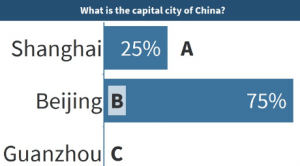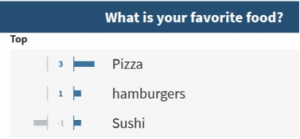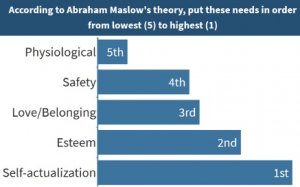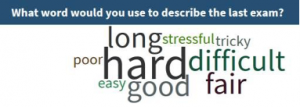Engaging Students in a Synchronous Distance Setting: Asking Online Questions
Christopher J. Hartwell, Ph.D.
Abstract
One major challenge in higher education is engaging student in the learning process, and this challenge is of particular concern in synchronous broadcast classes, where students are geographically dispersed. This paper argues that the use of online questions, that students can respond to using their electronic devices, is an effective way to increase student participation and engagement in such settings. Personal experience with one particular online question platform – Poll Everywhere (www.polleverywhere.com) – is used to illustrate potential capabilities, question types. Both advantages and challenges of using online questions are discussed.
Introduction
One of the biggest classroom challenges is keeping students engaged in the learning process. This challenge only becomes more pronounced in a synchronous distance broadcast educational setting, where the classroom instructor is not co-located with many, or any, of the students he or she is teaching (Bernard et al., 2004). This typically occurs when the instructor is teaching from one location, as students are watching from different locations (e.g., on a home computer or regional college campus). These contexts are not constrained by students and instructors having to be in the same physical location. Thus, they can be more convenient for the learner and open up the pool of potential learners, but it can be difficult for instructors to “reach through the screen” to engage students, who feel a lower sense of presence and a higher sense of anonymity when the classroom instruction is not face-to-face. However, matching teaching methods and technology to the distance instructional setting can help to increase student engagement (Valentine, 2002).
The purpose of this paper is to explain one method that could prove useful in minimizing the distance between the teacher and follower in synchronous broadcast classrooms – the use of online questions. Utilizing this format allows a course instructor to overcome some of the challenges often associated with teaching in a broadcast environment. It allows for all students to respond to questions simultaneously in real-time, rather than having one student answer at a time. In a broadcast environment especially, there is difficulty with managing students at various locations that may attempt to answer a verbal question at the same time, only to cut each other off or to not be heard at all.
Engagement and the Synchronous Distance Environment
Student engagement refers to the extent to which the learner is actively participating in and learning from the class environment of which he or she is a part. Research has indicated that students in distance learning environments tend to be less engaged in the learning process than those in face-to-face settings (Phipps & Merisotis, 1999; Webster & Hackley, 1997). One of the major issues with technology-mediated learning, such as synchronous broadcast or webcast, is a difficulty in eliciting student participation beyond passive listening and taking notes (Webster & Hackley, 1997). Potential transmission delays or students at different remote sites speaking at the same time may result in ineffective or misunderstood communication making students hesitant to verbally participate. The use of online question mitigates those concerns by allowing student to simultaneously respond to questions. In the remainder of this paper, I define and describe online questions, giving examples of when such questions may be integrated into synchronous broadcast classes. I utilize Poll Everywhere (www.polleverywhere.com) to illustrate and describe online questions, given my previous and current experience using that specific online question platform.
Introduction to Online Questions
Online questions refer to asking questions that instructors can ask and students can respond to using the internet and other technology (such as text messages). In essence, these questions allow students at multiple locations respond synchronously to a question without speaking. Consistent with media richness theory (Daft & Lengel, 1986), utilizing online questions increases the richness of the communication by facilitating student perceptions of greater interactivity and social presence (Burke & Chidambaram, 1996), in essence reducing the perceptual distance and making remote learners feel more active and a perceptually closer learning environment (McBrien, Jones, & Cheng, 2009). Such questions also increase the interaction level between the students and instructor, which has been found to increase teaching effectiveness in distance learning environments (Offir, Lev, & Bezalel, 2008).
The list of potential interfaces for asking online questions is long and continuing to grow (e.g., iClicker, Kahoot!, Mentimeter, Poll Everywhere, REEF Polling, Top Hat), and instructors should consider various factors when deciding which interface (if any) if right for their classroom situation. First, based on the course subject and instructor teaching style, which question types are most likely to be effectively utilized? Second, how will the online interface be incorporated into the current mode of instruction? For example, if you currently utilize presentation software (e.g., PowerPoint), can you integrate online questions directly into the presentation? Third, does the instructor’s department, college, and/or university contract with any specific technology-mediated question/polling companies? Finally, utilizing the answers to the first two questions, the instructor should research available options to determine which interface(s) can be utilized in a manner consistent with the purposes and design of the course, and what costs are associated with each option.
In doing the analysis for my own broadcast courses, I decided upon using Poll Everywhere for four main reasons. First, this online interface provides a variety of question types (to be discussed later) that match the topic and format of my broadcast courses. Second, Poll Everywhere utilizes technology that most students already have access to (i.e., smartphones, tablets, and computers), rather than requiring students to purchase a new device to respond to questions. Third, Poll Everywhere can be integrated directly into various presentation software, including PowerPoint, Keynote, and Google Slides. Finally, while my institution does not have a contract with Poll Everywhere, Poll Everywhere has a free option for educators that allows up to 40 responses per question/poll, and my broadcast classes size typically falls below this threshold. Thus, in this paper, I will use Poll Everywhere as a specific example of how technology-mediated questions can be used to engage students in the classroom. However, many of the points made will generalize to other online interfaces, and a different specific tool may be a better fit for your particular classroom situation.
Features and Question Types
With many technology-mediated question interfaces, you can create questions directly on their website and/or integrate questions directly into the presentation software that you currently use. Poll Everywhere, for example, has a separate download available for PowerPoint, Keynote, and Google Slides that allows the user to create and present questions directly from the respective presentation software. In addition, Poll Everywhere has a free downloadable app that allows instructors to use their device as a presentation remote, while offering added functionality as questions are displayed (e.g., toggling between hiding and showing question responses/results). Students can also download the free app to make answering questions easier, or answer questions by going to a specific URL in any web browser (and answer some questions via text message).
There is a variety of question types available across the various online question interfaces. An outline of the question types currently available on Poll Everywhere, along with sample uses and examples, is found in Table 1 (listed at the end of this article). The most commonly used type of online question is multiple choice or true/false. These questions involve presenting a question to students, with a finite list of potential responses. Used at the beginning of class, these questions could test students’ comprehension of the class readings. Used during or at the end of class, or during an exam review, these questions allow the students and instructor to gauge basic understanding of the content covered.
Open-ended questions are those that do not have a pre-defined list of possible answers, but rather allow the students to write their own response. Topical open-ended questions can measure students’ deeper understanding and/or memorization of the content, as such questions provide no cues or triggers in the form of pre-determined choices. Thus, these questions are more akin to fill-in-the- blank or short answer questions. Another potential use for these questions is soliciting anonymous feedback or sensitive information from the students. In these cases, the students may feel more comfortable providing honest responses when there is greater anonymity, as compared to raising their hands and speaking in front of the class.
Upvote-Downvote questions have two parts. The first part is similar to open- ended questions discussed above. But the second part entails allowing students to essentially agree or disagree with the responses of their classmates by voting each response up or down. This question type can be useful in class brainstorming activities, especially in determining which responses are most widely approved by the class at large. Similarly, this approach can be useful in gauging consensus of the class. For example, a question could be asked about what the instructor could do to enhance the effectiveness of time spent in class. Student responses might include such things as “allow more group discussions,” “give more relevant examples,” or “better explain what is going to be on the test.” Given that all of these options are competing for the same class time, it is important not only for individuals to express their own ideas, but for all class members to make a judgment as to the value of their fellow classmates’ suggestions.
Rank order questions allow students to put pre-designated options in a ranking order. Topically, this could be useful in determining if students understand steps in a progression or order in a timeline. Alternatively, it could also be beneficial in ascertaining student preferences. Take, for example, a situation in which a class period was canceled due to weather. The instructor could poll the class about how that change should affect the syllabus, giving the following options: (1) Push all classes back and eliminate the last topic on the syllabus, (2) Combine the topic from the missing class with a later class (covering each in less depth), or (3) Replace the class scheduled as “exam review” with the recently- missed class content. This allows the students a voice in the decision-making process, potentially leading to greater satisfaction with the final decision that is made.
Clickable image questions ask students to click on an area of an image, using provided stock images or an image uploaded directly by the instructor. These questions are useful for a wide variety of situations, and can be very creatively applied. For example, students can identify where they are from on a map, can identify a particular bone on a skeleton, or plot out coordinates on a graph.
Word Cloud questions, like open-ended and upvote-downvote questions, solicit free responses from students. The most commonly-found words are illustrated in a word cloud on the screen, allowing a visual representation of common themes or ideas. This question type can be utilized in such ways as establishing general student impressions or determining similarities and differences among class members during icebreaker activities.
Advantages and Challenges to Using Online Questions
The use of online questions can be an effective means of breaking the communication barriers that sometimes exist in broadcast classrooms, but there are also challenges associated with their use that also need to be considered. In this section, I first describe some of the major benefits that using online questions provide in a broadcast setting. I then turn to some of the disadvantages and challenges that can arise from using online questions.
Utilizing software to present online questions have many benefits, some of which have been discussed previously. First, the instructor is integrating technology that is almost always already being utilized by students in a broadcast learning environment – whether it is a computer, tablet, or smartphone. Second, not requiring the vocalization of answers has the benefit of engaging those introverted, quiet students that may have anxiety about speaking up in class. Thus, the instructor can engage a wider variety of students. Third, the use of this technology allows simultaneous participation from multiple locations, rather than one person at one location speaking at a time. Fourth, online questions get students actively involved in the learning, by integrating course concepts, familiar technology, and questions that require a participative answer from the students. Fifth, it adds variety that offers a break from the typical slide show presentation and/or verbal lecture. Sixth, it offers a student a low-risk opportunity for assessment of their learning, and practice/review for higher-risk assessments (e.g., exams, projects). Finally, online questions can offer student immediate feedback, which is becoming more expected across settings, due to technological advances.
While there are numerous advantages to using online questions in synchronous broadcast learning environments, there are also a variety of challenges associated with doing so. First, there is often a learning curve associated with selecting and utilizing a platform for presenting online questions. It requires the instructor to go outside of his or her comfort zone and try something new. However, as these platforms continue to grow and evolve, they tend to implement many design and functional features to assist the instructor using the platform for the first time. In fact, many of the platforms have online tutorials, user communities, and/or answers to frequently-asked questions that are useful in the initial learning phase, as well as in learning how to utilize additional features as the instructor becomes more familiar with the technology.
Second, each online question platform is different and has strengths and limitations that need to be taken into account. For example, I utilize the free educator version of Poll Everywhere, which allows me to implement questions directly into my presentation and obtain up to 40 responses to each question. However, I am not able to know who specifically responded and which individual provided each response. Nor am I able to receive more than 40 responses to each question. Thus, if I were teaching a 100-person class, or if I wanted to utilize my questions to identify specific individuals that were participating (such as to assign participations grades), I could not do so without paying to use a fuller version of Poll Everywhere that includes these options.
Finally, it is important to recognize that online questions are not a patch that will solve major problems associated with the instructor and/or content of the course. The instructor’s attitude and perceived motivation play an integral role in how students interpret and respond to instructor questions (Crane, in press), and some course material may not be conducive to the use of online questions. If online questions are used ineffectively (e.g., asking redundant questions, overuse of online questions), it could actually frustrate students and have a negative impact on student engagement.
Results of Using Online Questions
Online questions have been a part my courses for years, and I have found them especially useful in synchronous distance environments, such as broadcasts or webcasts. Numerous student evaluations I have received positively reflect on the use of online polling, noting that it is an excellent use of learning technology. Even classroom facilitators (university employees tasked with making sure that classroom broadcasting technology is working properly in each broadcast location) have noted that my classes using online polling have markedly more student engagement than other broadcast classes. Multiple facilitators have even suggested that I share this tool with other faculty members, and train them on effective usage. This paper is largely a response to that prodding, allowing me an opportunity to expound on the potential uses of online polling in the classroom, and to share with readers the positives and negatives that I have encountered along the way. Online polling is not the right fit for every class (probably not even every distance-learning class), but it is one tool to consider when developing a new course or updating an existing one, especially when student engagement is a concern.
Conclusions
When asked to give advice to instructors teaching in a synchronous distance environment, students detail the importance of involvement and participation (Webster & Hackley, 1997). The use of online questions allows the instructor the ability to equally reach out and involve students at numerous broadcast locations in a synchronous distance classroom environment. While the attitude and motivation of the instructor teaching in a synchronous broadcast environment play a large role how student interpret questions (Crane, in press; Valentine, 2004), the use of online questions can be an effective tool for quality instructors to solicit answers, comments, and feedback from remotely-located students. There are a numerous of platforms/interfaces that can be utilized to ask questions, each with different strengths and weaknesses. Different questions types available when using these platforms allows questions to be effectively utilized in a variety of situations and content areas. Poll Everywhere was identified as an illustration of how online questions could successfully be used. While there are some potential drawbacks to using online questions in a synchronous broadcast classroom, there are very strong advantages that can be realized through thoughtful integration of this technology in such a setting.
References
Bernard, R. M., Abrami, P. C., Lou, Y., Borokhovski, E., Wade, A., Wozney, L., Wallet, P. A., Fiset, M., & Huang, B. (2004). How does distance education compare with classroom instruction? A meta-analysis of the empirical literature. Review of Educational Research, 74, 379-439.
Burke, K. & Chidambaram, L. (1996). Do mediated contexts differ in information richness? A comparison of collocated and dispersed meetings. In J. F. Nunamaker, Jr., & R. H. Sprague, Jr. (Eds.), Proceedings of the 29th Annual Hawaii International Conference on System Sciences, 3, 92-101. Los Alamitos, CA: IEEE Computer Society Press.
Crane, B. D. (in press). Teacher openness and prosocial motivation: Creating an environment where questions lead to engaged students. Management Teaching Review.
Daft, R. L., & Lengel, R. H. (1986). A proposed integration among organizational information requirements, media richness, and structural design. Management Science, 32, 554-571.
McBrien, J. L., Jones, P., & Cheng, R. (2009). Virtual spaces: Employing a synchronous online classroom to facilitate student engagement in online learning. International Review of Research in Open and Distance Learning, 10, 1-17.
Offir, B., Lev, Y., & Bezalel, R. (2008). Surface and deep learning processes in distance education: Synchronous versus asynchronous systems. Computers & Education, 51, 1172-1183.
Phipps, R., & Merisotis, J. (1999). What’s the difference? A review of contemporary research on the effectiveness of distance learning in higher education. Report for The Institute for Higher Education Policy, 2-49.
Valentine, D. (2004). Distance learning: Promises, problems, and possibilities. Journal of Distance Learning Administration, 5:3, 1-11.
Webster, J., & Hackley, P. (1997). Teaching effectiveness in technology-mediated distance learning. Academy of Management Journal, 40, 1282-1309.
About the Author
Chris Hartwell is an Assistant Professor in the management department of the Jon M. Huntsman School of Business at Utah State University, where he teaches in face-to-face, online, and broadcast environments for both traditional and professional business students. He received his Ph.D. in Organizational Behavior and Human Resource Management from Purdue University, and he is a certified HR professional with more than eight years of professional work experience. He has presented at annual conferences for such international organizations as the Academy of Management and the Society for Industrial and Organizational Psychology.
| Question Type | Explanation | Sample Uses | Screenshot Example |
|---|---|---|---|
| Multiple Choice or True/False | Students are tasks with selecting the answer to a question from a finite list of possibilities |
|
 |
| Open-ended | Students are tasked with answer to question without a finite list of possibilities |
|
 |
| Upvote-Downvote | Similar to an open-ended question, but students can approve or diapprove of each other’s responses |
|
 |
| Rank order | Student are given a finite list of options (similar to a multiple choice question), but students rank the options instead of choosing just one |
|
 |
| Clickable Image | Students are shown an image, and respond by clicking on a specific place on the image. |
|
 |
| Word Cloud | Words from open-ended responses are shown on the screen, with larger words representing higher frequency |
|
 |
| Note: Question types and screenshot examples were derived using Poll Everywhere (www.polleverywhere.com). | |||
